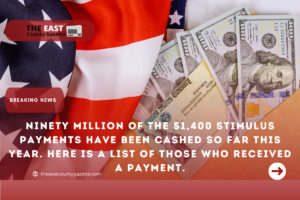There are over 90 million Americans who have received the $1,400 stimulus payments in their bank accounts.
The payments were made as part of the first wave of payments, which totaled more than $242 billion, according to announcements made Wednesday by the Treasury Department, the Internal Revenue Service, and the Bureau of the Fiscal Service. Additional payments will be made
The first deployment of checks was deposited on Wednesday, marking the beginning of the formal “payday.” By 9 a.m. local time, the funds had been transferred to account holders’ accounts.
Those who submitted their information through the IRS non-filer tool last year, as well as those who provided direct deposit information on their 2019 or 2020 tax returns, are among those who would benefit from this first batch.
According to the Internal Revenue Service, the vast bulk of the stimulus payments will be made by direct deposit. In addition, the government has mailed over 150,000 paper cheques totaling approximately $442 million.
Unless you receive the money quickly, it is possible that it will arrive in the future weeks.
Why do some people receive $1,400 payments earlier than others
When President Joe Biden signed the American Rescue Plan into law last Thursday, he gave the government the green light to begin issuing the payments.
Some Americans were able to withdraw money from their bank accounts before the official payout date on Wednesday.
The Internal Revenue Service stated on Friday that it would begin distributing the funds.
“Some Americans may notice that direct deposit payments are pending or that provisional payments have been made in their accounts before the official payment date of March 17,” the IRS stated in a statement.
Some firms, such as Chime, a fintech banking start-up, decided to make the cash available to its consumers as soon as possible. Some people were perplexed as to why other traditional banks had not followed suit, prompting them to wonder why.
Understanding why some payments were made early and others weren’t received until March 17 boils down to understanding the so-called ACH Network and how it operates, which is discussed further below.
The Automated Clearing House (ACH) Network is a payment system that allows direct deposits and payments to accounts at U.S. banks and credit unions located throughout the country.
Read More: IRS Filing Deadline Is Early – Here’s Everything You Can Expect From Your Refund
According to the National Automated Clearing House Association, or Nacha, the body that controls the Automated Clearing House Network, there is a corresponding date associated with each ACH payment — or direct deposit — instruction received.
On the 17th of March, two things happened. The money was transferred from the United States government to banks and credit unions. The banks and credit unions were then given a deadline by which they had to make the monies available to customers for withdrawal (generally 9 a.m. local time).
It is possible that any payments made ahead of time were made by financial institutions who advanced the money in accordance with instructions they received on who was to be paid and how much.
From the time the first payment file was transmitted on Friday, March 12, to the time when all beneficiaries would have access to the money on Wednesday, there is no mystery as to where the money has gone — it is still in the possession of the government, according to the organization.
According to the Consumer Bankers Association, there is often a two-day customary waiting period before accounts are funded for these types of transactions, if not more.
This provides the government with additional time to correct any potential problems. It also enables organizations to conduct fraud investigations and troubleshoot problems.
As a result, financial institutions that advance the cash before the deadline do so at their own risk and expense.
According to the Treasury Department, subsequent rounds of payments will likewise be made through an ACH settlement that will take place every Wednesday after the date on which the payments are issued.
The government will resend the payments in the form of paper checks if the funds do not go through as planned. Debit card payments will be accepted for all other mailed payments as well.
